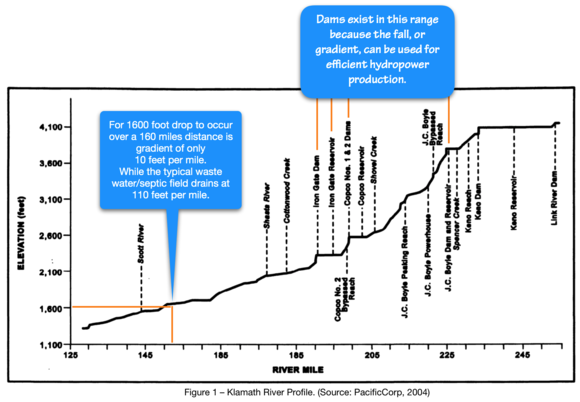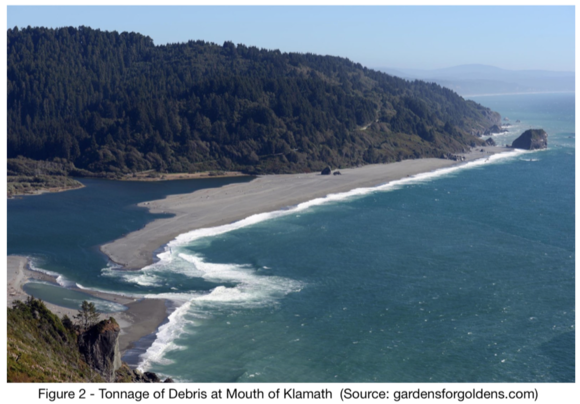|
Below are comments which I submitted to Oregon Department of Environmental Quality with regard to their initial public review of a section 401 water quality certificate for the proposed removal of the J. C. Boyle dam on the Lower Klamath River. (PDF of actual letter is available here.)
TO: ODEQ Hydroelectric
Specialist,
Current
and future Oregonians are, and should continue to be, beneficiaries of the
monumental achievements in water infrastructure that has created Oregon’s
exemplary agricultural economy. The proposed removal of the four PacifiCorp
dams, including the J. C. Boyle dam in Oregon, will destroy that very
infrastructure.
Therefore,
I stand alongside the majority of tax-payers and citizens in firm opposition to
ODEQ’s approval of a water quality certification request for the J. C. Boyle
Dam removal project.
The
dam removal effort has too many uncertainties which bear negatively on
long-term water quality, river habitat and fish spawning grounds due to the
river dynamics and existing sedimentary buildup behind the dams.
These
dams serve several environmentally beneficial functions by first, creating a
series of reservoirs which diminish turbidity and improve water quality as
water moves through the system. These reservoirs are essentially giant settling
ponds for particulate matter, including erosional debris, dead algae,
cobble-sized sediment, pebbles, and valley-fill alluvium.
Particulate
organic matter, that originates from Upper Klamath Lake, basin agricultural
return flows, municipal and industrial sources in the Klamath Falls area, is
largely trapped by the J. C. Boyle reservoir.
The overall nutrient loads, including naturally occurring phosphorous
rich material, settles behind the dam and never reaches the slower moving and
shallower gradient portions of the river system. In turn, Copco 1, Copco 2 and
Iron Gate Dam reservoirs also serve to keep sedimentary debris from flowing
further downstream.
Although,
all four reservoirs are known to have elevated organic loads, they still serve
as excellent sedimentary traps. Current estimates range from 15 million to 30
million cubic yards of sediment behind all four dams. The J. C. Boyle dam, had
an estimate that was originally 1.5 million cubic yards. Today the estimate has
been forced into a range that is deemed politically acceptable, at 600,000
cubic yards. This number is still a ridiculously large volume of sedimentary
debris to consider flushing into the California river system. Flushing this
debris would be unconscionable and would cause catastrophic harm to the overall
river environment, downstream fish populations, spawning grounds and riparian
habitats.
Additionally,
the toxicity of these enormous volumes of muck and sedimentary composites have
not been sufficiently studied. Mining operations have long surrounded the river
system throughout So. Oregon and No. California. A U.S. Geological Survey
review of mine data (2005), highlights that these past operations released
elevated amounts of toxic substances into the watershed, including arsenic,
chromium, copper, lead, mercury, nickel, tungsten, uranium, and zinc.
Oregon
has been tightening rules, initiating moratoriums and legislating outright bans
on various small-volume run-of-river dredge mining operations for years.
Therefore, ODEQ should have serious reservations about the
complexities involved in this potential toxic stockpile and be less insistent
on approving this certification. Otherwise, the citizens will recognize this
current 401-certification process is a politically motivated, agenda-driven
water quality charade reeking with double-standards.
The
existing dams provide beneficial cleansing structures which allow the massive
fresh-flow tributaries, and downstream volumes of low phosphoric, clean water
from the western-slope to actually improve water quality as it travels the 250
miles to the Pacific Ocean.
ODEQ
should never consider allowing this potential toxic debris into the river
system. First, it will never make it to the Pacific Ocean because deep boulder
pockets, gravel and cobble bars and the subsequent multiple confluence
embankments and ridges that occur along the lower elevations will trap the
overwhelming tonnage of debris.
Additionally,
the downstream gradient is too shallow, and the river flows will never be
sufficient to mobilize the debris field. ODEQ’s permit approval pretends to
only be concerned about water quality in Oregon. This is indefensible because
all of these toxins, muck and sedimentary debris will devastate the lower
river.
The
downstream impacts cannot be ignored. From River Mile 160 to the Pacific Ocean
the gradient approaches a mere two percent (.1893) grade (Figure-1). The drop
to sea level is only a 1600-foot change in elevation, which is only 10 feet per
mile. ODEQ certainly knows the typical waste-water or home septic system would
require a slope of 110 feet per mile to drain efficiently

While
dam critics often complain that dam construction has altered the natural
sediment transport processes reducing gravel bar and pocket gravel deposits and
thereby reducing salmonid and lamprey spawning and rearing habitats, dam
removal is not the solution
The
purposeful disbursement of Oregon’s debris field into California’s portion of
the Klamath River system would be an immoral act.
In
fact, the debris flow today, with the dams in place, is too heavy for the
current channelized flows to successfully push into the Pacific. Even with the
benefit of increase flows used for dissolution and flushing programs, which are
regulated by the dam structures, there is insufficient flow to clear the mouth
of the river (Figure-2).

The
J. C. Boyle dam:
•
Provides cool water
for the continued operations of Iron Gate Fish Hatchery which releases 7
million anadromous fingerlings annually
•
Provides clean,
renewable, low-cost hydroelectric power for 70,000 households
•
Reduces peak flood
flows by 25 percent
•
Reduces algae blooms
in the Lower Klamath River
•
Reduces river
temperatures in the Lower Klamath River
•
Reduces river
sedimentation and debris buildup in the Lower Klamath River
•
Provides for lakeside
camping, hiking, fishing, boating and recreational opportunities
•
Provides river rafting
and business opportunities
•
Provides reservoirs
for bio-remediation, while trapping toxins and sediment
•
Allows for flow
control and remediation techniques, such as flushing flows
These
positive attributes provide enormous public benefit and sufficient reason for
ODEQ’s denial of this step in the dam removal certification process.
In
closing, there is another item that ODEQ must consider – Cost. Original cost
estimates ranged from $1.4 billion and upwards. After 2010, when the US
Congress first balked at funding the destruction of the Klamath Dams, there was
an enormous effort to “find cost reductions.” The results offered nothing more
than cost shifting and slight-of-hand congressional Gerry-rigging of payments
from various agency-level accounts. Never-the-less, the public was told of a
new cost estimate of $800 million, a reduction of $400 million. Today, the
Klamath River Renewal Corp. estimates total cost at $400 - $450 million
dollars, an estimated reduction of nearly $1 billion. It appears that if we
wait a couple of more years the cost would be halved again!
I
suggest, that a neat and tidy, $1 billion cost reduction from the original
estimates with an overall price-tag of only $400 million cannot be legitimate,
at least not using the same project scope and equivalent efforts. This begs the
question, what items will be added to complete the dam removal project and who
will fund future restoration and remediation efforts?
No
doubt, tax-payers will end up paying the full-price. They will be burdened with
millions of dollars of cost-overruns, future water quality issues, higher rates
for base-load electricity, devastated habitat and riparian areas, and the
destruction of private property, all because of an over-whelming, unfathomable
mindset intent on destroying western civilization’s technological advances.
Oregonians
should be the beneficiaries of the monumental investments, hard work and
successful achievements made possible by our state’s water infrastructure.
Oregon’s status as a modern agricultural and technological engine has been made
possible by inexpensive base-load electricity and abundant, well-managed water
resources.
Please
ensure our heritage by denying approval for the 401 Water Quality Certificate
for the removal of the J.C. Boyle dam.
Sincerely...
Remember, if we don't stand for rural-Oregon values and common sense – No one will!
 Dennis Linthicum
Oregon State Senate 28
Capitol Phone: 503-986-1728
Capitol Address: 900 Court St. NE, S-305, Salem, Oregon 97301
Email: sen.DennisLinthicum@oregonlegislature.gov
Website: http://www.oregonlegislature.gov/linthicum
|